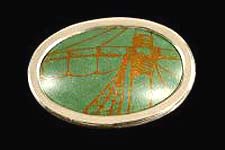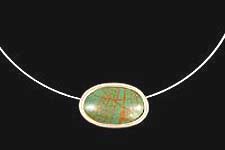How a Historic Cupola Became Copper Art
 New Bedford Copper Cupola Brooch by artist Chelsea Bird
New Bedford Copper Cupola Brooch by artist Chelsea BirdCourtesy of the New Bedford Whaling Museum
The New Bedford Whaling Museum may seem to be an odd point of origin for a line of copper jewelry, but it makes perfect sense-once you know the story. The story begins in 1907, when the museum was established in New Bedford, Massachusetts, the whaling capital of the world in the 19th century. The museum preserves the history of the American whaling industry, and it's the largest one to do so in the United States.
One of the museum's six buildings is the Bourne Building, constructed in 1916 as a gift by Emily Bourne in memory of her father, whaling merchant Jonathan Bourne, Jr. Boston architect Henry Vaughan designed the building, which includes a small tower capped by a bell-shaped, copper cupola. With the museum located in the middle of historic downtown atop Johnny Cake Hill, the original cupola rose high above the landscape for nearly 100 years.
With decades of exposure to New England's unforgiving weather, however, the copper cupola weakened and needed to be replaced. So in 2006, the original 16-ounce sheet copper was removed-all 500 square feet-and a new cupola was installed. The new one was faithful to its predecessor's shape and size, but it was made using a more durable 20-ounce copper.
At this point, the museum had an enormous amount of weathered copper on its hands-copper with a history and a rich green patina. The museum director decided that rather than simply recycling the metal in a traditional way, they would use it to create art. So the director contacted the art department at the University of Massachusetts at Dartmouth, and the process of turning a century-old cupola into copper art began.
 New Bedford Copper Cupola Necklace by artist Chelsea Bird
New Bedford Copper Cupola Necklace by artist Chelsea BirdCourtesy of the New Bedford Whaling Museu
Seven current and former students were invited to work with the historic copper, with the goal of creating designs for a museum show. Chelsea Bird was among the seven, having just graduated in 2006 with a double major in jewelry and textile design.
According to Bird, the artists were given ample freedom to create their own designs, but there were a few guidelines. They needed to create one design for a one-of-a-kind piece and another design for a piece to be sold, one that could be replicated ten times.
Bird designed a unique line of handmade jewelry using the delicate, weathered copper, creating a matching necklace, brooch and a set of earrings. Pleased with her design, the museum store began carrying the pieces to raise funds for the museum. She explained that using the historic copper from the Whaling Museum as her medium had an enormous influence on her design. For inspiration, she had studied the museum's artifacts, slowly browsing through their collection and sketching.
Two things in particular stood out: The first was the museum's extraordinary collection of scrimshaw, an art practiced by New England sailors on whaling ships. The second was the display of model sailing ships, especially their complex rigging. Inspired by images of intricately incised ivory and the patterns of masts and ropes, she decided to incorporate the historic themes into her work. To create the image of rigging featured on her jewelry, Bird used a technique she described as scrimshaw in reverse. She essentially turned the process around, "scratching off the lighter patina and bringing out the copper below," she explained.
She had also noticed that the oval was popular in scrimshaw jewelry, and that New Bedford's antique shops carried many brooches set horizontally. These factors influenced her oval design and the horizontal setting of her brooch and necklace. And of course, the gently domed shape was a reminder of the cupola itself.
Because of the nature of the material, however, achieving the domed shape wasn't easy. In fact, preserving the patina "was our biggest concern," says Bird, explaining that the artists couldn't bend the material very much without endangering the thin green membrane. Fortunately, she was able to bend the copper very carefully using hydraulic press forming. Another challenge was the need to seal the copper patina, which was finally done with the right application of spray lacquer.
"It was definitely a good problem-solving experience to work with the material to preserve its unique qualities," adds Bird.
The jewelry she created truly reflects the history of the material's physical changes as well as the history of its surroundings. In the end, there really is a connection between the New Bedford Whaling Museum and a line of copper jewelry. It all makes perfect sense-once you know the story.
Resources:
Also in this Issue:
- The Lee Robertson Method of Copper Arts
- Still Life on Copper: The Process of Discovery
- How a Historic Cupola Became Copper Art
- The Art of Early Copper Tools
- Cast Images: American Bronze Sculpture Highlights New York Works
